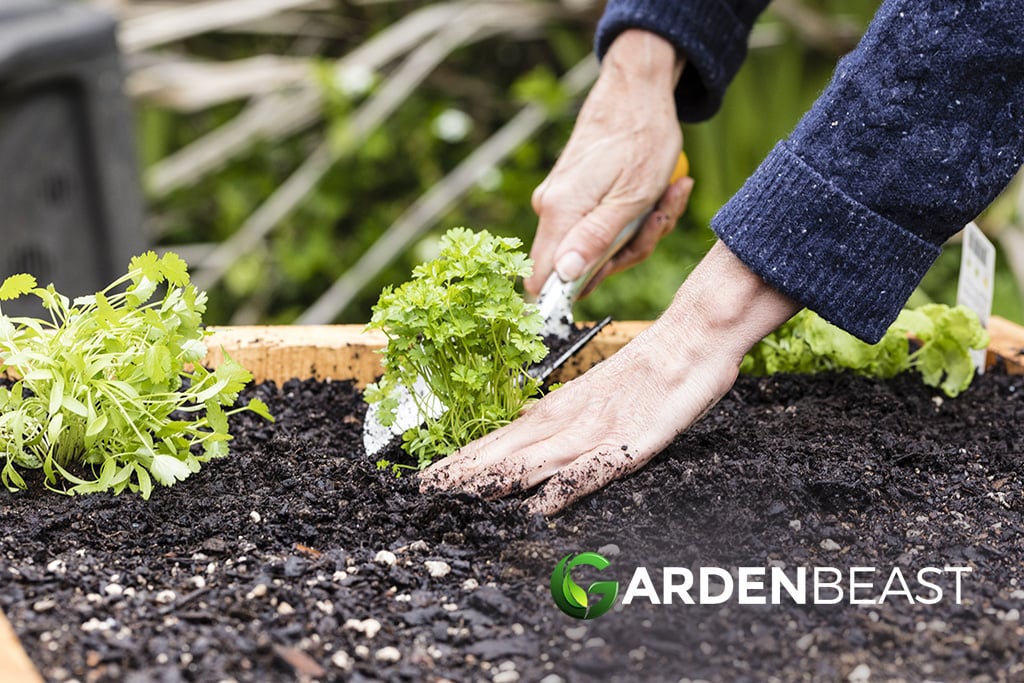Raised garden beds are a very productive and economic way to grow food in your front yard. There are many advantages to choosing raised beds over in-ground ones.
For instance, a raised garden bed can be installed pretty much anywhere as long as it gets at least six hours to sunlight so, it is safe to say that you can garden anywhere.
Additionally, you can take advantage of small spaces by setting the plants closer together, and, depending on your preferences, you can decide whether you need your garden bed to be simple or more elaborate.
But, before you start building your own raised garden bed or get one installed, there are a few important aspects that you should consider. Read on to learn about garden beds location and set-up, what plants to choose, when to start planting, and how to water and tend your garden.
What is the best location for a raised garden bed?
- If you want your plants to thrive in your raised garden bed, it’s very important to remember that they should receive at least six hours of full sun every day.
- All plants love the sun so, you should consider installing the garden bed in the sunniest part of your garden.
- Soggy soil is your worst enemy, so avoid placing a garden bed in areas that are damp and dark.
- During the growing season, the garden will need to be watered regularly, so make sure you have access to a hose.
So, now that you found the ideal location for your raised garden bed, it’s time to learn about a key ingredient – good soil.
As we mentioned above, raised beds have many advantages including the fact that they allow you to choose a blend of soil that’s more nutritious than the native soil of your yard. Plants need a lot of nutrients and water, so it’s best to choose a type of soil that’s loose and rich with organic matter and nutrients. By doing this, you ensure that the roots of your plants will have a sustained growth process.

Raised Bed Garden Kit – 42″ x 84″ x 8″, From Amazon
Removing the perennial weeds and grass before installing your raised bed is another important aspect. This can easily be done with a shovel or a garden fork. For better moisture retention and effective drainage, loosen approximately 6-10” of native soil. This means that if your raised bed is just 5” high, its actual depth will be 12-18”, so your plants will have plenty of room to grow.
How tall should a raised garden bed be?
A great thing about raised garden beds is the fact that they provide great drainage for the soil within the bed.
- The most common height for raised garden beds is around 11” which is the height of two regular “2×6” wooden boards. This height is ideal and provides sufficient drainage for most crops.
- But, according to most gardening experts, you should give your plants a minimum of 18” soil depth, so, to get great results the raised bed should be placed on top of an additional 12” of soil.
Here’s a list of depth requirements for some of the most common vegetables:
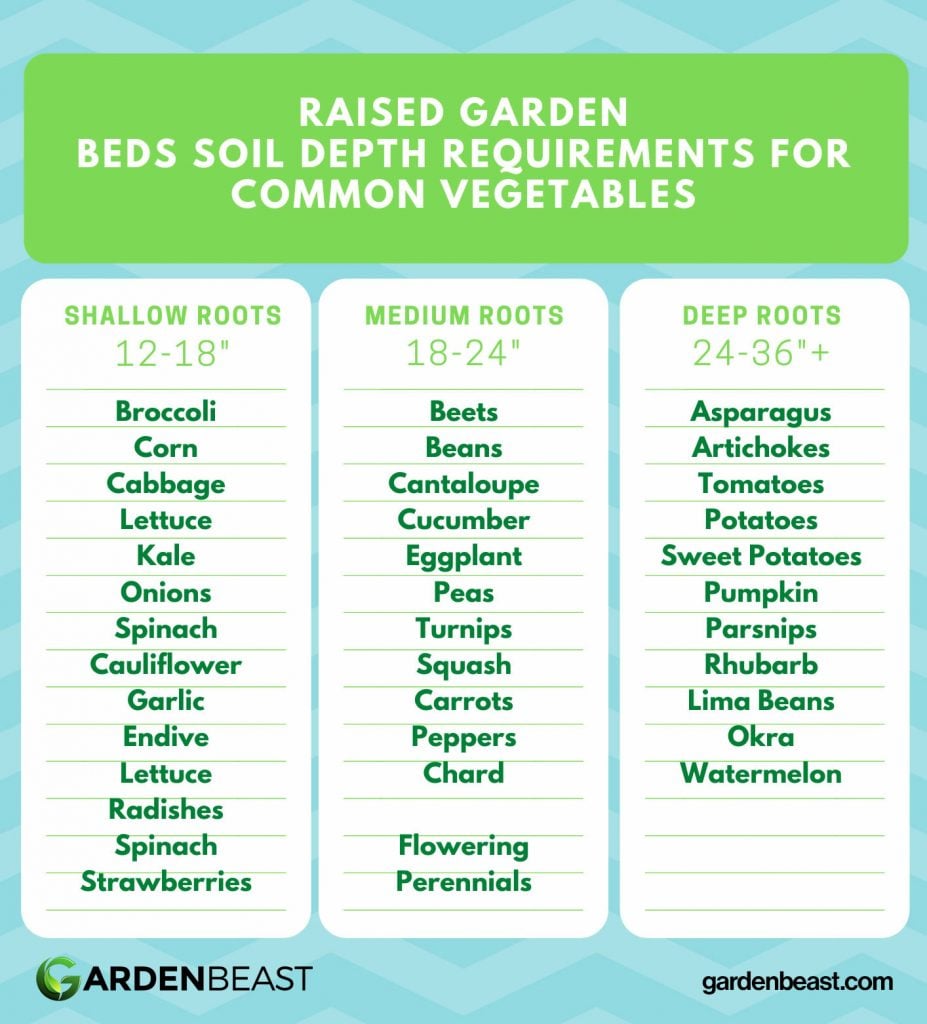
As you already know, raised garden beds are above ground level and are quite well-drained because of it allowing the soil to warm up earlier in spring.
As a result, the growing season will be longer and you’ll be able to set out transplants sooner. To protect your transplants and young seedlings from strong wind and late frosts, you can install a cold frame on top of the bed.
Once the crops are stronger, you can simply lift off the cold frame and move it to another bed if necessary.
Another important aspect that you might want to consider when choosing the ideal height for your raised garden bed is the amount of bending over that you want to do.
If you are young, fit, and have a strong back, then kneeling or bending over to tend to your garden won’t be a problem. But, if you have mobility issues and want to avoid back strain, you can opt for a taller raised bed.
Gardeners who have limited mobility due to age or who are in a wheelchair will often choose elevated planters. These containers have the same depth requirements as raised beds, so if you choose elevated planers, make sure you give your plants enough soil, fertilizer, compost, and mulch.
Raised beds that are taller, will automatically hold more volume. Consequently, watered soil will be much heavier and will exert more pressure. This can cause your garden bed to bulge and warp.
If the garden bed is longer than 6” and taller than 12”, you can prevent the sides from bowing by installing cross-support across the width of the bed and in the center. You can either build your supports out of aluminum, plastic, or wood or buy them from raised beds manufacturers.

Galvanized Raised Garden Bed Kit, From Amazon
What is the perfect soil for raised garden beds?
You can think of your raised garden bed as a fun controlled experiment that allows you to test different soils and see what works best. If, however, you want to increase your chances of success, you need to find the perfect combination of organic materials suck as beneficial microbes and other microorganisms and nutrients like minerals and nitrogen.
The easiest way to buy bags of topsoil and compost and fill up the raised bed or the elevated container. If you’re lucky enough to have your own compost or a reliable source, even better.
But, regardless of what the source of your soil and compost is, you’ll probably need to fine-tune it. For instance, greens thrive in soil that has low levels of nitrogen, while tomatoes require a slightly acidic soil.
When it comes to compost, whether it’s manure or any other kind, you need to make sure that they are completely finished, or that they aren’t ‘hot’. If you are looking for good drainage, which is something that most root vegetables need, you also need to add materials like vermiculite, pumice, peat, or even sand.
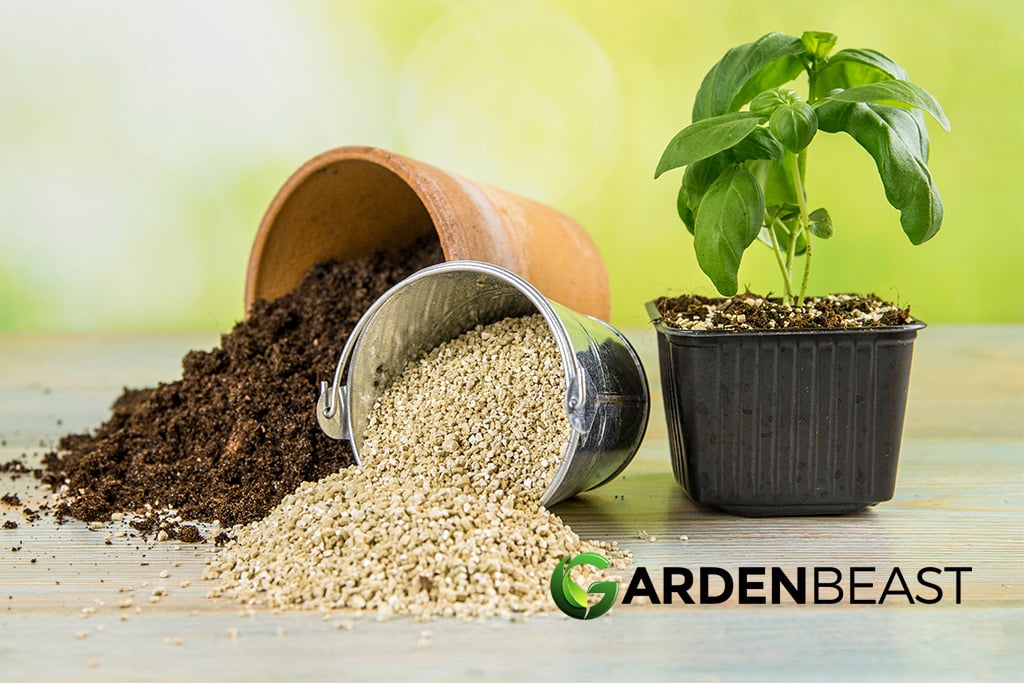
The easiest way to prepare compost and making it garden-ready is by spreading it over the raised beds in the fall and leaving it to freeze through the winter. But because this isn’t always possible and sometimes you have to make the compost on the spot, you can use bales of straw instead.
These will smother the weeds and will also condition the soil underneath. Strawbale gardening is an organic and effective technique, so you might want to try it out, especially if you’re into organic gardening.
To have a nice yield of healthy and delicious vegetables, it’s highly recommended to go for organic garden soil. This type of foil should be aerated and loose, rich in minerals and nutrients that are essential for bountiful yields and steady plant growth.
If you are preparing to fill your raised garden beds, you should take advantage of this opportunity and get high-quality soil.
Here’s a great garden soil recipe developed by Joe Gardener:
- 50% high-quality topsoil (purchased in bags from a trusted brand or regionally-sourced)
- 30% high-quality homemade/certified compost
- 20% organic materials (leaves, mineralized soil blend, vermicompost, ground bark, mushroom compost, or cow/poultry manure).
- Avoid using horse manure (it contains too many weed seeds), peat moss (it is not a sustainable resource), artificial fillers (hinder drainage and break down too fast), or fill dirt (doesn’t have enough nutrients).

Nature’s Care Organic & Natural Raised Bed Plant Food, From Amazon
Don’t forget about mulch
Mulch is great! It protects your plants from pests, erosion, heat, and it enriches your soil with nutrients as it slowly breaks down over time. The process of mulching will prevent water evaporation, so you won’t have to add supplemental water and without it, raised beds are more likely to dry out.
Exposed soil can develop a water-resistant crust that prevents the roots from hydrating and getting nutrients and it can also be blown away by strong winds. Luckily, these problems can all be solved easily by adding mulch.
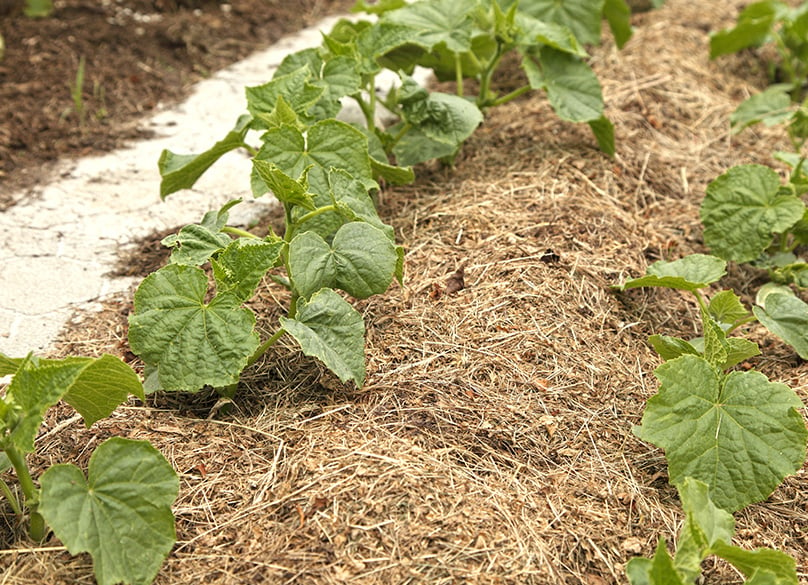
Another great advantage of mulch is that it looks really nice. Ideally, the layer of mulch should be between one and two inches and should consist of shredded bark, composted leaves, wheat straw (which is becoming more and more popular), arborist wood chips, and pretty much any natural material.
What to plant in a raised garden bed?
The best advice that we can give you is to fill your raised garden beds with the plants and veggies that you like to eat.
- If you love eating salad, then go ahead and plant lettuce, cucumbers, radishes, onions, carrots, and cherry tomatoes.
- If you prefer eating cooked food, you should go for peppers, potatoes, herbs, eggplants, beans, etc.
- After choosing your favorite plants, you can spice things up by including at least one less familiar vegetable. Growing it and discovering it will make your raised garden bed more fun.
Take a look through our growing guides section for detailed information about growing each type of fruit or vegetable.
But, let’s not forget the main reason behind choosing this type of gardening which is maximizing productivity. The biggest challenge is growing as much food as possible without suffocating your plants by squeezing in too many.
Plants don’t thrive in overcrowded garden beds because they are in constant competition for nutrients and water and their roots don’t have enough space to grow. So, make sure you calculate the height that your plants will reach and plan your garden accordingly. It’s also important to consider the growing habits of each plant, whether they are climbing, bushy, or trailing.

These growing habits will affect their neighbors. For instance, it’s perfectly fine to plant lettuce next to carrots, as their growing habits are complementary, but you shouldn’t plant lettuce next to cucumbers.
The great majority of vegetables can be started from seed directly in the raised garden beds. In some cases, however, it would be best to start out with a plant as this will shorten the growth cycle by up to a month or even more.
In a colder region with a growing season of 100 days or less, pepper plants and tomatoes do not have enough time to mature before frost when started out from seeds.
In other words, seedlings will give you a head start so they make sense for vegetables like tomatoes and peppers, but seeds make more sense for lettuce and carrots.
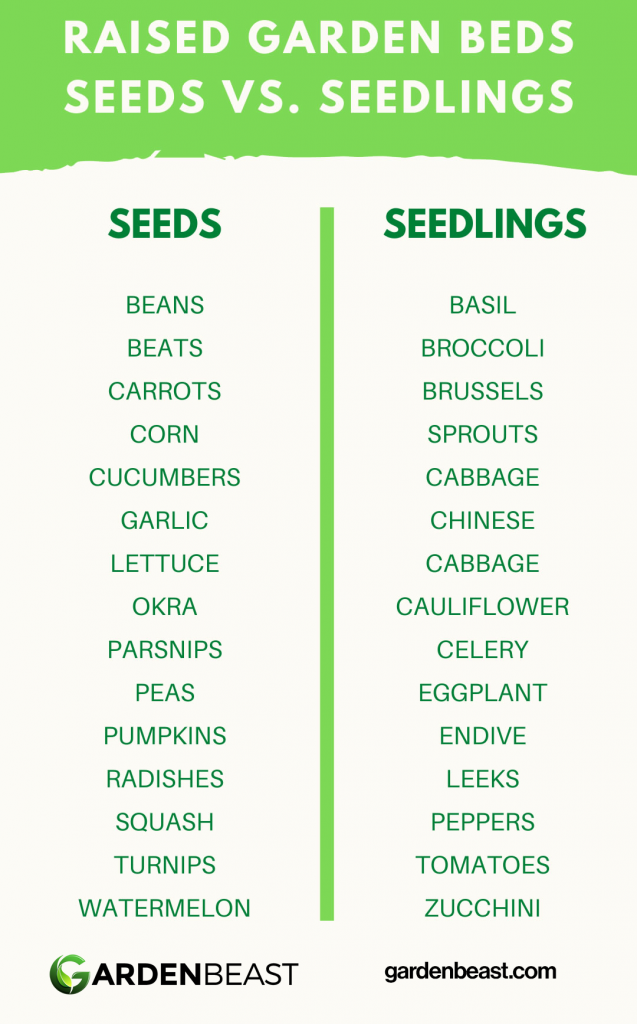
When can you start planting your raised garden beds?
There are a few important aspects that you need to take into account when deciding when to start planting your raised garden.
Firstly, you need to think of the type of plants that you are putting in. For instance, broccoli and lettuce can be planted earlier because they can withstand cool weather.
Tomatoes and basil, on the other hand, can only tolerate temperatures higher than 40°F or 4°C.
You can refer to the calendar below to determine the best time to plant your favorite vegetables.

This calendar is quite useful, but you also need to consider the frost dates and soil temperature of your area.
Plants that are sensitive to cooler temperatures should be planted only as soon as you know that the danger of frost has passed (usually between March and May, depending on where you live). You can easily find out your growing zone by checking this Plant Hardiness Zone Map.
If you live in zones 8-10, frost won’t be the main thing that you need to worry about, but excessive heat. To avoid midsummer heat, come hot-climate gardening experts prefer to plant in the fall, rather than spring while others prefer to plant twice each year, early fall, and late winter.
Another key aspect that is worth considering is the soil temperature.
- The great majority of plants prefer moderate soil temperatures that range between 60°F and 70°F (15°C and 21°C). But this doesn’t apply to all plants.
- Spinach and peas thrive in cooler soil that’s around 45°F (7°C)
- while melons and eggplants won’t germinate unless the soil is warmer than 60°F (15°C).
- Peppers, tomatoes, corn, and squash are normally planted only once each season
- while other crops like peas, beans, salad greens, onions, and root crops can be planted and harvested twice.
Once you plant the seeds, make sure you water the area more than usual to achieve several inches of moisture. The soil should be watered generously until the seeds germinate and the first set of true leaves have appeared on the seedlings.
Seeds usually have a solid coating that can only soften if there’s enough moisture in the soil. This process takes a few days, but, if the soil dries out the germination can be interrupted and you might have to reseed.

To ensure that the soil remains damp during the germination process, you can cover it with a garden fabric that can be removed as soon as the plants are established.
The best weather for transplanting young seedlings into your raised garden beds is cool, calm, and drizzly. Seedlings are too fragile to withstand sun, wind, and extreme temperatures.
If the weather isn’t adequate, you can protect your seedlings with garden fabric. Tender seedlings will need a few days to establish new roots and to fully adjust to the new environment, so make sure you protect them from wind and sun and give them plenty of water every day or two for a minimum of two weeks.
How to water raised garden beds?
The best way to check whether the soil needs to be watered or not is by touching it. If the soil feels slightly damp, like the clothes that are freshly out of the washing machine, then you’re all good.
Most plants thrive in soil that’s slightly moist and can wither if the soil is too wet or too dry, so finding the right balance is quite important.
Specialists advise that you should always water your raised garden beds in the morning. This gives the soil time to dry out during the day. If you water in the evening, the cool temperatures might prevent water from evaporating and you risk drowning the plants.
Rain can also be an issue. Too little rain can be fixed with hand watering, but how do you fix too much rain? For starters, you can use a rain gauge to measure the amount of rain that has fallen. After too much rain, it’s important to keep a close eye on your crops, aerate the soil if possible, and to remove the weeds and the slugs that are very likely to appear in wet weather.

Different types of soil will hold water differently. For instance, sandy soil will let water pass quicker than a clay-based soil. A high-quality soil like the one described in the first part of the article should retain some moisture while also having a good level of drainage.
As usual, the key is finding the right balance. Plants use their roots to absorb oxygen, so, if the soil is wet for a long time, they might drown. To avoid this, you can add compost to the soil. The compost will act like a sponge and will store more water while also letting some of it through. The main benefits of adding compost to your raised garden bed are its ability to aerate the soil and to keep it well-drained.
If it’s very hot outside, you might notice that the plants tend to wilt during the day. This isn’t a cause for concern and doesn’t necessarily mean that the soil is too dry.
This can simply be the plant’s way of avoiding moisture loss. When in doubt, you should always check the soil with your finger. If you determine that the soil is indeed too dry, you have a few different options.
You can use a water wand to deliver the water quickly and easily right where it’s needed. Or, if you are too busy to do this on a regular basis or are going on vacation, you can invest in an automated sprinkler system or soaker hose.
Drip irrigation systems are extremely effective as they distribute the water slowly. To get the best results, make sure you don’t let the soil dry out completely. If the fragile roots wither, the plant will direct all of its energy to grow other roots instead of producing fruit. Additionally, plants that are water-stressed will taste bad.
How to tend to your raised garden beds?
To keep the weeds at bay, you should plant intensively. In early spring, you might have to take the weeds out constantly, but by midsummer, when your crop starts to grow, you won’t have to worry about this anymore.
The best thing to do when you notice weeds is to remove them as quickly as possible. This will prevent them from stealing all the good nutrients, moisture, and root space.
It is worth mentioning that the soil in raised garden beds keeps moisture for a longer period of time than it does in regular garden beds. The sides of the bed will retain moisture and the plants will shade the soil, so water evaporation will be reduced.
Once the plants have grown, you won’t need to water them as often, unless it’s exceptionally hot and droughty.
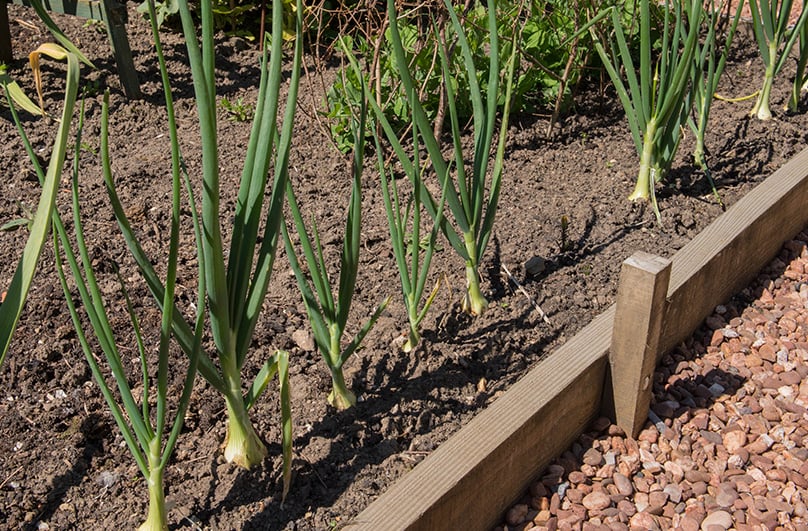
If your crops take three or four months to reach maturity, you might want to repeat the fertilization process. Applying a dose of water-soluble fertilizer on a monthly basis will help your plants grow, especially if they consist of seaweed, humic acid, and fish emulsion.
These nutrients are great for plants as they get absorbed quickly and keep them in good shape when the weather isn’t ideal. This is an effective way to prevent disease and keep pests at bay.
Spent fruit and foliage should be removed and the same procedure should be applied to diseased and damaged plants. Make sure you address any issues quickly, especially when it comes to pests.
As soon as the veggies look ready to eat, you can begin harvesting them. It’s recommended to harvest fruits and vegetables right before their ripeness peak because that’s when they are the most nutritious and tasty.
